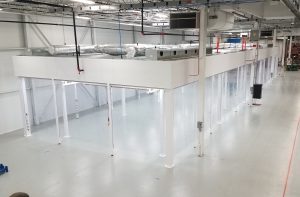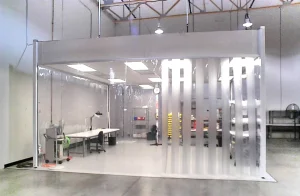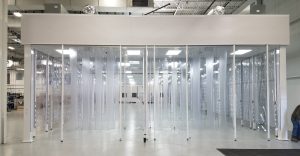Softwall Cleanrooms
Softwall Cleanrooms from Pacific Environmental Technologies are a quick, easy, and economical solution combining the strict requirements of a cleanroom with the low cost, portability, rapid deployment, and configurability of modular systems.
Strong and lightweight, our softwall cleanrooms can be installed as free-standing structures or hung from your existing ceiling. Units of different sizes can be combined to create spaces of nearly any size and classification, or areas of differing classifications.
Our softwall cleanroom systems can cover an area up to 24 ft. x 24 ft. with a single unit (576 sq. ft.; 7.3m x 7.3m, 53.5 sq. m.) utilizing 4 legs (larger sizes require additional support legs) and can achieve classifications from ISO 8 to ISO 5 (Class 100,000 to Class 100).
Softwall cleanrooms are ideal solutions for smaller operations, temporary expansions and capacity upgrades, and areas where space is limited. Contact Us to discover how our softwall cleanrooms can best benefit your application.
What is a Softwall Cleanroom?
Softwall cleanrooms are a type of modular cleanroom resembling a tent-like structure that uses flexible vinyl curtains for the walls instead of rigid modular panels. Economical, lightweight, and easy to setup and disassemble, softwall cleanrooms are the ideal solution for temporary expansions, capacity upgrades, to protect specific pieces of equipment, or for smaller-scale operations such as pharmaceutical compounding.
Softwall cleanrooms are generally constructed using a steel or aluminum frame and use vinyl curtains to enclose the area instead of rigid walls. They typically employ a t-grid ceiling and utilize motorized fan-filter units (FFUs) to provide filtered air to the cleanroom. Typically, softwall cleanrooms are designed as a single-pass system, meaning that filtered air is introduced from the HEPA filters overhead, where it proceeds straight-down before being exhausted out of the bottom. Because of this type of design, softwall cleanrooms do not recirculate air and rarely employ systems that rely on air recirculation, like comfort cooling.
Durable, economical, and lightweight, the modular nature of softwall cleanrooms gives them unparalleled flexibility, portability, and configurability, allowing for easy modification, combination of multiple units, expansions, and segmentation to create areas of differing classifications.
Sizes & Classifications:
Our softwall cleanrooms are available in a range of standard sizes suited to different applications. Our standard size softwall cleanrooms are kept in stock to ensure the quickest delivery time available to you. Each unit is packaged disassembled in sealed wood crates to ensure protection during transport, or opt for our factory installation and our installation technicians will deliver and assemble your softwall cleanroom quickly and efficiently.
|
|
Available Softwall Cleanroom Classifications: |
||
|---|---|---|
| ISO Classification: | FED STD 209E Equivalent: | Air Changes per Hour (ACH): |
| ISO 5 | Class 100 | 250 to 350 ACH |
| ISO 6 | Class 1,000 | 75 to 120 ACH |
| ISO 7 | Class 10,000 | 45 to 60 ACH |
| ISO 8 | Class 100,000 | 25 to 35 ACH |
Frequently Asked Questions:
-
FAQ 1: What is the difference between a hardwall and softwall cleanroom?
Like the name suggests, hardwall modular cleanrooms use rigid, interlocking panels to create a free-standing structure. These are typically used in small-to-medium sized operations requiring stricter pressure, temperature, and humidity control or in applications requiring superior cleanliness, but at significantly greater cost and time.
Softwall cleanrooms are a canopy-like structure utilizing flexible wall materials (typically vinyl curtains) fixed to a metal frame. Low-cost, lightweight, portable, and durable enough for demanding manufacturing processes, softwall cleanrooms are quickly becoming the ideal solution for a range of applications.
-
FAQ 2: How soon can I expect delivery of my softwall cleanroom?
Before manufacturing begins, our engineers will meet with your design team to discuss your specific design requirements. Depending on the complexity of your specific application, a set of plans will be drafted for your final approval in 2 to 4 weeks. Once your team has given final approval on design, manufacturing will take 2 to 8 weeks depending on the size of your application.
From initial discussion to approved drawings, manufacturing, and packaging, most orders are generally ready for shipping within 6 weeks. Depending on your location, shipping can take an additional 4 to 6 weeks.
-
FAQ 3: Is there an option for delivery and installation?
Though our softwall cleanrooms are easy to assemble with basic tools, Pacific Environmental Technologies also offers delivery & installation services at additional cost for hassle-free deployment and testing at your facility. The additional cost of this is subject to the size of your cleanroom, any additional shipping expenses, and your distance from us. Speak with one of our sales or design engineers for additional information.
-
FAQ 4: Can I air condition my softwall cleanroom?
Absolutely! Instead of drawing ambient air from outside the cleanroom, softwall cleanrooms can draw cooled, conditioned air supplied by a separate HVAC system (optional). Note that this configuration can place a large amount of strain on your HVAC system, since the cooled air will (typically) be exhausted from the bottom of the cleanroom instead of recirculated.
-
FAQ 5: What curtain options are available?
Pacific Environmental Technologies offers a range of curtain options to suit a variety of applications, including: clear, frosted, blackout, UV-filtering (amber), and anti-static (ESD safe). We also offer a range of thicknesses including 40, 60, and 80mil for durability.
-
FAQ 6: Can the softwall cleanroom be modified to accommodate our equipment?
Yes. We have a range of door and entry systems to accommodate specific or oversized equipment, cranes, conveyors, and more. Additionally, the curtains and ceiling can be modified with custom penetrations to support process utilities, pass-through chambers, conveyor openings, and more.


